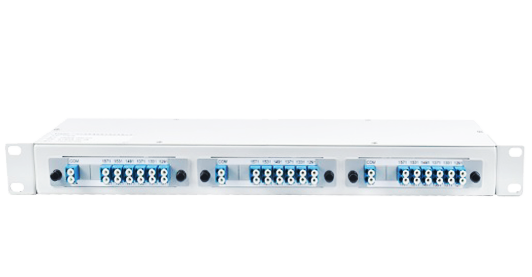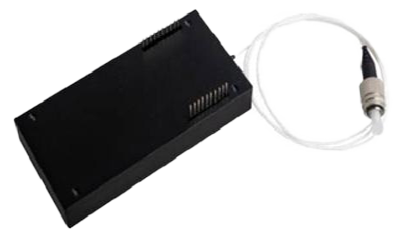Flexible networking, occupies less space, and super expansibility.
Supporting CWDM/DWDM/EDFA/OLPS/OTAP and other business cards hot-swapping mode.
Supporting SDH/SONET/POS/EPON/GPON/CPRI/SAN/ETHERNET service access at various rates.
Supporting single-fiber unidirectional, single-fiber bidirectional, dual-fiber bidirectional chain, star and ring types and other networking methods.
Supporting client access from different vendors, interconnecting with devices from multiple vendors, supporting client devices as single mode (1310nm/1550nm), multi-mode (850nm/1310nm), electrical port (RJ45), etc., can realize OADM optical add-drop multiplexing function, and intermediate nodes can be up and down wavelength.
Supporting SNMP-based unified network management platform, the network management methods include CLI, WEB, NetRiver (graphical interface).
Supporting 1 + 1 power hot swapping redundant backup, AC and DC power supply is optional.
Hirundo optical line protection products effectively solve the problems of fiber transmission damage, line interruption, equipment power failure, and board failure, which seriously affect the stability of the transmission network in the existing network. It solves the practical problems of causing great pressure on customers, self-efficiency and line maintenance.
Application 1: Point-to-Point Networking
Point-to-point transmission utilizes one or two core optical fiber resources to multiplex dozens of times of optical fiber channel to realize the transmission of multiple different types of services (SDH, SONET, Internet, SAN, etc.) in one or two core optical fibers.

Figure 1: Point-to-Point Networking
Application 2: Chain Networking
Chain transmission uses wavelength division multiplexing (WDM) equipment and optical add-drop multiplexing (OADM) equipment to cooperate with each other. In addition, the multi-path service between each node is constructed to construct a chain network in the metro optical communication to realize the interconnection and interoperability of multiple different types of services (SDH, SONET, Internet, SAN, etc.) between each node in one or two core optical fibers.

Figure 2: Chain Networking
Application 3: Ring Networking
The ring network transmission uses the upper and lower multi-path services between each node of WDM equipment to construct the ring network transmission network in metro optical communication. It realizes the interconnection and interoperability of multiple different types of services (SDH, SONET, Internet, SAN, etc.) between each node in one or two core optical fibers.

Figure 3: Ring Networking
System Parameter | Technical Index |
Maximum capacity of single system | 4, 8 and 16 waves. |
Wavelength range | Compliance with ITU-T G.692, ITU-T G.695 standard. |
Service access types | PDH, EPON, GPON.
SDH: STM-1/STM-4/STM-16/STM-64/STM-256.
SONET: OC-3/OC-12/OC-48/OC-192/OC-768, FE, GE, 10GE, 40GE, 100GE, CPRI 1~7, POS, FICON, ESCON, CATV. |
Optical port transmission mode | Adopts 2R transmission mode, each channel supports 32M~111.81Gbit/s rate transparent transmission; Adopts 3R transmission mode, each channel supports155Mbit/s, 622Mbit/s, 1.25Gbit/s, 2.488Gbit/s, 4GFC, 8GFC, 10GFC, 11.3Gbit/s, 40Gbis/s, 100Gbis/s rate. (Optional). |
Physical network topology | Chain type, Star type and Ring type. |
Fiber type | G.652, G.653 (not recommended), G.655. |
Network management mode | CLI, NetRiver, WEB. |
Product dimension | 482(W)*44(H)*285(D)(mm). |
Environmental requirements | Working temperature | -10℃ ~ 70℃. |
Storage temperature | -40℃ ~ 80℃. |
Relative humidity | 5% ~ 95% no condensation. |
Power supply requirements (standard value) | 220V/AC, 50Hz; -48V/DC (optional). |
Safety and EMC | Compliance with FCC, UL, CE, TUV, CSA standards. |
Power consumption | <120W. |
2U Optical Line Protection System
System Parameter | Technical Index |
Maximum capacity of single system | 4, 8, 16 and 40 waves. |
Wavelength range | Compliance with ITU-T G.692, ITU-T G.695 standards. |
Service access types | PDH, EPON, GPON.
SDH: TM-1/STM-4/STM-16/STM-64/STM-256.
SONET: OC-3/OC-12/OC-48/OC-192/OC-768, FE, GE, 10GE, 40GE, 100GE, CPRI 1~7, POS, FICON, ESCON, CATV. |
Optical port transmission mode | Adopts 2R transmission mode, each channel supports 32M~111.81Gbit/s rate transparent transmission. Adopts 3R transmission mode, each channel supports155Mbit/s, 622Mbit/s, 1.25Gbit/s, 2.488Gbit/s, 4GFC, 8GFC, 10GFC, 11.3Gbit/s, 40Gbis/s, 100Gbis/s rate. (Optional). |
Physical network topology | Chain type, Star type and Ring type. |
Fiber type | G.652, G.653 (not recommended), G.655. |
Network management mode | CLI, NetRiver, WEB. |
Product dimension | 482(W)*89(H)*285(D)(mm). |
Environmental requirements | Working temperature | -10℃ ~ 70℃. |
Storage temperature | -40℃ ~ 80℃. |
Relative humidity | 5% ~ 95% no condensation. |
Power supply requirements (standard value) | 220V/AC, 50Hz; -48V/DC (optional). |
Safety and EMC | Compliance with FCC, UL, CE, TUV, CSA standard. |
Power consumption | <200W. |
4U Optical Line Protection System
System Parameter | Technical Index |
Maximum capacity of single system | 4, 8, 16, 40, 48, 80 and 96 waves. |
Wavelength range | Compliance with ITU-T G.692, ITU-T G.695 standards. |
Service access types | PDH, EPON, GPON,
SDH: STM-1/STM-4/STM-16/STM-64/STM-256
SONET: OC-3/OC-12/OC-48/OC-192/OC-768, FE, GE, 10GE, 40GE, 100GE, CPRI 1~7, POS, FICON, ESCON, CATV. |
Optical port transmission mode | Adopts 2R transmission mode, each channel supports 32M~111.81Gbit/s rate transparent transmission; Adopts 3R transmission mode, each channel supports155Mbit/s, 622Mbit/s, 1.25Gbit/s, 2.488Gbit/s, 4GFC, 8GFC, 10GFC, 11.3Gbit/s, 40Gbis/s, 100Gbis/s rate. (Optional). |
Physical network topology | Chain type, Star type and Ring type. |
Fiber type | G.652, G.653 (not recommended), G.655. |
Network management mode | CLI, NetRiver, WEB. |
Product dimension | 482 (W)*177(H)*250(D)(mm). |
Environmental requirements | Working temperature | -10℃ ~ 70℃. |
Storage temperature | -40℃~ 80℃. |
Relative humidity | 5% ~ 95% no condensation. |
Power supply requirements (standard value) | 220V/AC, 50Hz; -48V/DC (optional). |
Safety and EMC | Compliance with FCC, UL, CE, TUV, CSA standard. |
Power consumption | <300W. |













